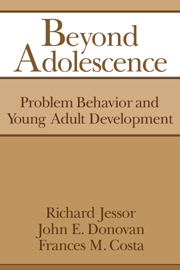Book contents
- Frontmatter
- Contents
- List of tables and figures
- Preface
- Part I The approach
- Part II Young adulthood
- 4 The participants as young adults
- 5 Problem behavior in young adulthood
- 6 Psychosocial correlates of problem behavior in young adulthood
- Part III Development and change
- Part IV Conclusions
- Name index
- Subject index
6 - Psychosocial correlates of problem behavior in young adulthood
Published online by Cambridge University Press: 07 October 2009
- Frontmatter
- Contents
- List of tables and figures
- Preface
- Part I The approach
- Part II Young adulthood
- 4 The participants as young adults
- 5 Problem behavior in young adulthood
- 6 Psychosocial correlates of problem behavior in young adulthood
- Part III Development and change
- Part IV Conclusions
- Name index
- Subject index
Summary
From the perspective of Problem-Behavior Theory, the explanatory account of behavior depends on the joint consideration of variables in the different systems of the conceptual framework. The multivariate logic of the theory, summarized by the concept of psychosocial proneness described in Chapter 2, has been supported by the findings from the earlier phase of this research (Jessor & Jessor, 1977). The earlier data demonstrated that the key measures in the Personality, Perceived Environment, and Behavior Systems of Problem-Behavior Theory were able to account for substantial amounts of variance in a variety of specific problem behaviors among adolescents and college-age youth. The measures of those psychosocial risk factors mapped overall proneness to involvement in problem behavior, and reflected an underlying dimension of conventionality–unconventionality.
In this chapter, we examine the relation of young adult personality, perceived environment, and behavioral characteristics to young adult involvement in problem behavior. Two main objectives are addressed. The first is to establish the specific psychosocial risk factors that are related to greater problem-behavior involvement in this young adult stage of the life course. The primary focus is on those variables or risk factors that were identified in the earlier, adolescent phase of the research and that best represent the concept of psychosocial proneness. In addition, other personality and perceived environment characteristics that are unique to this young adult phase of the research will also be examined.
- Type
- Chapter
- Information
- Beyond AdolescenceProblem Behaviour and Young Adult Development, pp. 129 - 156Publisher: Cambridge University PressPrint publication year: 1992

